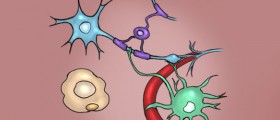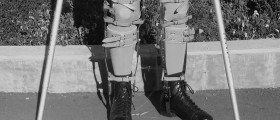
Spinal Cord
Spinal cord (medulla spinalis) is a part of central nervous system located in the spinal canal (Canalis vertebralis) and protected by the spinal vertebrae, which, depending on the spinal group may be cartilaginous or osseous. Its mid-extending central channel (Canalis medullaris) is wrapped in gray mass which is further coated with a white mass. Sensitive nerves that lead to the brain and motor nerves that lead to the peripheral organs depart from spinal cord.Gray mass contains: frontal (motor) horns (Cornu motoria) or front columns (column anterior), which build the front root of spinal nerve back (sensitive) horns (Cornu senzitiva) or back columns (column posterior), containing sensitive roads lateral horn (Cornu laterale) or columns (column lateralis) which contain the vegetative centers. White mass is the outer part which is divided by grey mass horns into three even strips: the front (anterior funiculus) the side (lateral funiculus) the back (posterior funiculus). Motor pathways (nerves that transmit stimulation from central nervous system to the periphery) depart from the front and side strips. Sensitive pathways that transfer stimulation from the periphery to the central nervous system start from back strip. Besides these, there are associative pathways which connect the different parts of the spinal cord.
Functions
Spinal cord is the oldest phylogenetic part of central nervous system. It performs two main functions: reflex and impulses transmission.Reflex function
This function is achieved through the different reflex centers located in the spinal cord: elementary (basic) reflexes - bending (flexion) and stretching (extension) of limb muscles muscle tone - all muscles are in a some state of tension (tone) due to constantly sent impulses from the spinal cord that irritate them vasomotor reflex - spreading and narrowing of the lumen of blood vessels reflexes of urination and defecation sexual reflexes - erection and ejaculation in men.Transmitting function
This function is manifested in the transmission of impulses in two directions, from the periphery to the brain and vice versa so there are two different types of conductive paths: ascending pathways are located in the back and side strips. They transfer impulses from the spinal cord to higher parts of the central nervous system, brain stem, cerebellum and cortex of the brain. These roads hand over all informations which are received by receptorsdescending pathways are located in the front and the lateral strips of the spinal cord. Spinal cord receives impulses from the higher parts of the central nervous system which trigger or inhibit the motor neurons. As a result there is a change of working organs activities: skeletal, muscle, and internal organs. These routes include pyramidal road which transmits impulses from the motor cortex area of the cerebrum to motor neurons of the spinal cord.



_f_280x120.jpg)


_f_280x120.jpg)


_f_280x120.jpg)





Your thoughts on this
Loading...